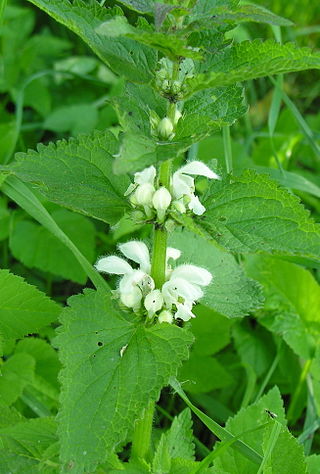
The dicotyledons, also known as dicots, are one of the two groups into which all the flowering plants (angiosperms) were formerly divided. The name refers to one of the typical characteristics of the group: namely, that the seed has two embryonic leaves or cotyledons. There are around 200,000 species within this group. The other group of flowering plants were called monocotyledons, typically each having one cotyledon. Historically, these two groups formed the two divisions of the flowering plants.

Smilacaceae, the greenbriers, is a family of flowering plants. While they were often assigned to a more broadly defined family Liliaceae, most recent botanists have accepted the two as distinct families, diverging around 55 million years ago during the Early Paleogene. One characteristic that distinguishes Smilacaceae from most of the other members of the Liliaceae-like Liliales is that it has true vessels in its conducting tissue. Another is that the veins of the leaves, between major veins, are reticulate (net-shaped), rather than parallel as in most monocots.
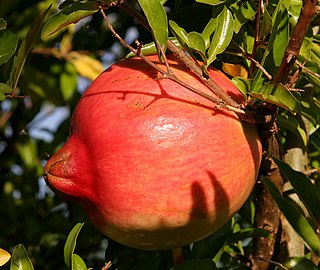
Punica is a small genus of fruit-bearing deciduous shrubs or small trees in the flowering plant family Lythraceae. The better known species is the pomegranate. The other species, the Socotra pomegranate, is endemic to the island of Socotra. It differs in having pink flowers and smaller, less sweet fruit.

Lythraceae is a family of flowering plants, including 32 genera, with about 620 species of herbs, shrubs, and trees. The larger genera include Cuphea, Lagerstroemia (56), Nesaea (50), Rotala (45), and Lythrum (35). It also includes the members of the former families of the pomegranate and of the water caltrop. Lythraceae has a worldwide distribution, with most species in the tropics, but ranging into temperate climate regions as well.

The Drosophilidae are a diverse, cosmopolitan family of flies, which includes species called fruit flies, although they are more accurately referred to as vinegar or pomace flies. Another distantly related family of flies, Tephritidae, are true fruit flies because they are frugivorous, and include apple maggot flies and many pests. The best known species of the Drosophilidae is Drosophila melanogaster, within the genus Drosophila, also called the "fruit fly." Drosophila melanogaster is used extensively for studies concerning genetics, development, physiology, ecology and behaviour. Many fundamental biological mechanisms were discovered first in D. melanogaster. The fruit fly is mostly composed of post-mitotic cells, has a very short lifespan, and shows gradual aging. As in other species, temperature influences the life history of the animal. Several genes have been identified that can be manipulated to extend the lifespan of these insects. Additionally, Drosophila subobscura, also within the genus Drosophila, has been reputed as a model organism for evolutionary-biological studies, along with D. sechellia for the evolution of host specialization on the toxic noni fruit and Scaptomyza flava for the evolution of herbivory and specialist on toxic mustard leaves.
Xiphinema is a genus of ectoparasitic root nematodes commonly known as dagger nematodes. The genus is of economic importance on grape, strawberry, hops and a few other crops. Major species include X.americanum, X.diversicaudatum, X.index, X.italiae and X.pachtaicum. They can be easily recognized by their long bodies and stylets which are long enough to reach the vascular tissue of plants. Different members of the genus have been shown to induce moderate to large amounts of root damage through root penetration, which in some species results in the formation of galls. They are of agricultural concern because they are vectors of nepoviruses, transferring them during feeding. Efforts to study these nematodes in more detail have proved problematic in some species due to difficulties in maintaining populations in a greenhouse environment.

The free-living nematode Panagrellus redivivus, is known to many aquarium enthusiasts and fish keepers as the microworm. It is a tiny roundworm used as the first food for larger kinds of newly-hatched fish, such as larval common carp. The microworm is widely used in aquaculture as food for a variety of fish and crustacean species.
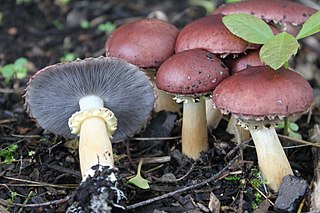
Stropharia rugosoannulata, commonly known as the wine cap stropharia, "garden giant", burgundy mushroom, king stropharia, or wine-red stropharia, is a species of agaric mushroom in the family Strophariaceae native to Europe and North America. Unlike many other members of the genus Stropharia, it is regarded as a choice edible and is commercially cultivated.

Mesostigmata is an order of mites belonging to the Parasitiformes. They are by far the largest group of Parasitiformes, with over 8,000 species in 130 families. Mesostigmata includes parasitic as well as free-living and predatory forms. They can be recognized by the single pair of spiracles positioned laterally on the body.

Monochamus is a genus of longhorn beetles found throughout the world. They are commonly known as sawyer beetles or sawyers, as their larvae bore into dead or dying trees, especially conifers such as pines. They are the type genus of the Monochamini, a tribe in the huge long-horned beetle subfamily Lamiinae, but typically included in the Lamiini today.

Anguina is a genus of plant pathogenic nematodes.
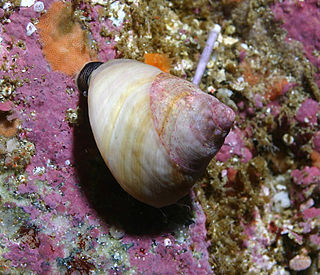
Trochoidea is a superfamily of small to very large vetigastropod sea snails with gills and an operculum. Species within this superfamily have nacre as the inner shell layer. The families within this superfamily include the Trochidae, the top snails. This superfamily is the largest vetigastropodan superfamily, containing more than 2,000 species.

Lecithocera is a genus of moths in the lecithocerid subfamily Lecithocerinae. The genus was erected by Gottlieb August Wilhelm Herrich-Schäffer in 1853.

Gervillia is an extinct genus of prehistoric bivalves belonging to the family Bakevelliidae.
The Steinernematidae are a family of nematodes in the order Rhabditida.

Sertularia is a genus of hydroids in the family Sertulariidae.
Paul W. Sternberg is an American biologist. He does research for WormBase on C. elegans, a model organism.
Lovenella is a genus of cnidarians belonging to the family Lovenellidae.
Panagrolaimidae is a family of nematodes belonging to the order Rhabditida.
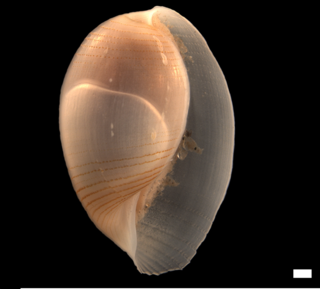
Roxania is a genus of gastropods belonging to the family Alacuppidae.














